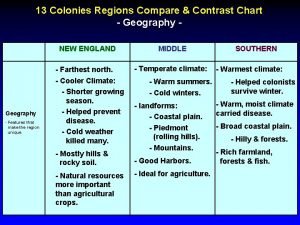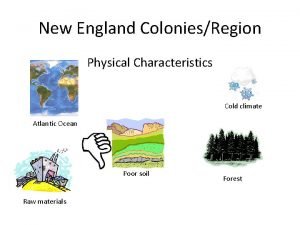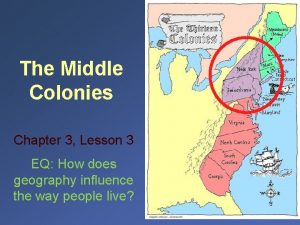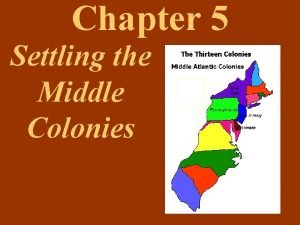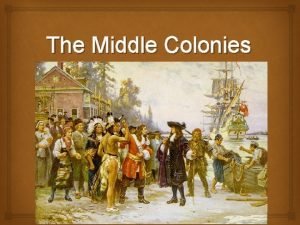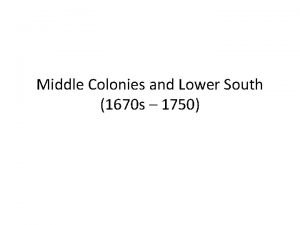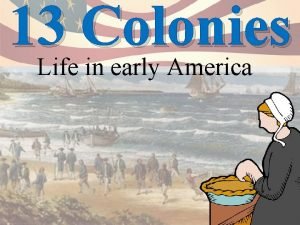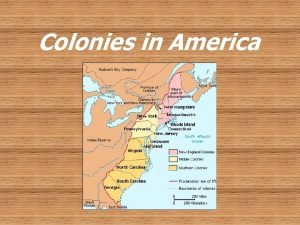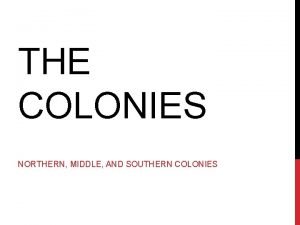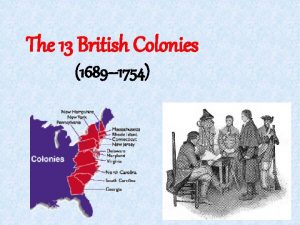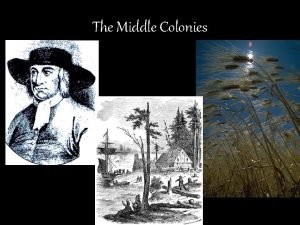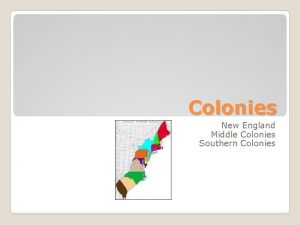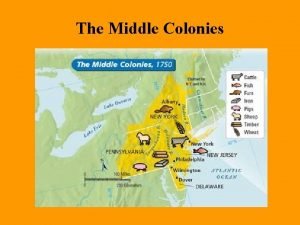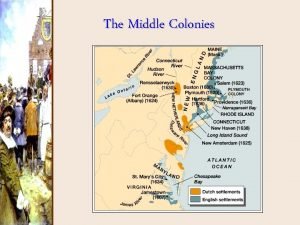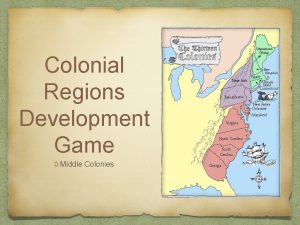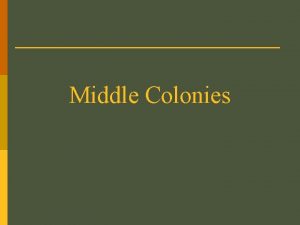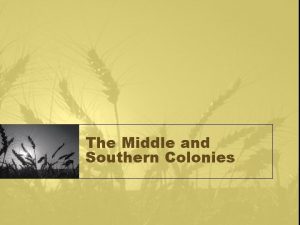War in the Middle Colonies 1776 1779 The













- Slides: 13

War in the Middle Colonies: 1776 -1779

The Hudson River Corridor The British offensive of 1777 included a plan to split the Colonies in two by controlling the Hudson River Corridor. Colonial Leaders: Horatio Gates, Daniel Morgan and Benedict Arnold British Leaders: General John Burgoyne, General St. Leger and General William Howe Outcome: The three-prong assault on the city of Albany fails (St. Leger and Howe fall short) and Burgoyne is captured at Saratoga. The Battle of Saratoga is seen as the “turning point” of the war because the French agree to assist the Colonists afterward.

Philadelphia Instead of helping Burgoyne, Howe decided to capture the colonial capital of Philadelphia in August 1777. Colonial Leaders: George Washington British Leaders: General William Howe Outcomes: After devastating defeats at Brandywine and Germantown, Washington forced to retreat. This retreat allowed Howe to keep the colonial capital as the Continental Congress fled to York, Pa. Howe waited throughout the winter for terms of surrender that never came.

Valley Forge George Washington’s winter quarters just outside of Philadelphia. From this position, the army could rest while keeping an eye on the British troops. Colonial Leaders: George Washington, Marquis de Lafayette and Baron von Steuben “British Leaders”: Freezing temperatures and hunger Outcomes: The six-month experience saw the heaviest losses for the Continental Army (2, 500 die). However, the survivors received valuable training from European allies, especially Baron

Monmouth In June 1778, General Howe was replaced by General Clinton for his role in losing Saratoga. Clinton, always liking NYC better, evacuates Philadelphia. Colonial Leaders: George Washington, Charles Lee and Baron von Steuben British Leaders: General Clinton Outcomes: Washington orders an attack on the rear of Clinton’s lines as the travel across New Jersey. Continental Army shows its new strength by fighting large British force to a draw. This was a moral victory and the last major engagement in the North.

War in the Southern Colonies: 1780 -1781

Charlesto(w)n The entry of the French and stubborn defense of Washington in the Middle Colonies convinced the new British commander, Henry Clinton to change strategies. May 12, 1780 the British invade Charlestown, South Carolina. Colonial Leaders: Benjamin Lincoln and Horatio Gates British Leaders: Generals Henry Clinton and Charles Cornwallis Outcome: The loss of over 5, 000 troops and 120 cannons to Clinton in Charlestown forced Washington to send Horatio Gates, the hero of Saratoga, to South Carolina. Cornwallis easily crushes Gates on August 16, 1780 at Camden, South Carolina. These losses cemented British control over the South and forced the Americans to a guerilla war.


British pacification efforts backfire in the South Pacification means using military victories to reduce rebellion or encourage a peaceful resolution. The British tried to pacify the South by putting Tories in charge of the government and militia of the area. Tories, or loyalists, in the South were mostly poor farmers or landless laborers. Once the British armed these loyalists, they sought revenge against the much wealthier Patriots. The British could not control this violence. The British also used economic policies to pacify the South. The Dunmore’s Proclamation would give any slaves who fought for the British freedom at the end of the war. This inadvertently created more Patriots. Also, the longer British forces were chasing the guerilla American units in the countryside, the more agitated the average Southern citizen became.

Cowpens and Guilford Courthouse General Greene quickly rebuilds the Continental Army and harasses Cornwallis’ forces. The British engage in “slash and burn” tactics to cut Greene’s supplies, but ends up alienating many Southerners. At Cowpens (Jan. 1781) and Guilford Courthouse (March 1781) Continental and British armies finally meet in battle. Colonial Leaders: General Nathaniel Greene and Daniel Morgan British Leaders: Cornwallis and Banastre Tarleton Outcome: Although the armies split the battles (US win Cowpens and Brit. Win Guilford) the result was that the British were losing momentum and supplies. Desperate for reinforcements, Cornwallis sends word to Clinton that he is returning to the coast for help from the Navy. He begins to head towards the coast of Virginia.


Yorktown Cornwallis retreats to Yorktown, on the Virginia coast with the goal of setting up a camp on the sea where Clinton can send supplies. While GW is training with the French in Rhode Island he learns of Cornwallis’ move and the availability of the French Caribbean Fleet. He plans a bold joint operation. Colonial Leaders: George Washington, General Rochambeau, Admiral De Grasse and Marquis de Lafayette British Leaders: Charles Cornwallis Outcomes: The joint operation of 11, 000 American troops, 6, 000 French troops and the French Navy were able to cut British relief supplies and reinforcements and trap Cornwallis at Yorktown. Although the British will continue to have troops in NY and Charlestown for another year, Cornwallis’ surrender is often viewed as the last battle of the American Revolution.

 13 colonies population 1776
13 colonies population 1776 Slavery in the 13 colonies chart
Slavery in the 13 colonies chart New england human characteristics
New england human characteristics The middle colonies
The middle colonies Guided reading lesson 3 the middle colonies answer key
Guided reading lesson 3 the middle colonies answer key Middle colonies homes
Middle colonies homes What did the middle colonies do
What did the middle colonies do Circa 1750
Circa 1750 Interesting facts about the middle colonies
Interesting facts about the middle colonies New england, middle and southern colonies comparison chart
New england, middle and southern colonies comparison chart Southern colonies
Southern colonies Northern middle southern colonies
Northern middle southern colonies Middle colonies
Middle colonies Important facts about the middle colonies
Important facts about the middle colonies

